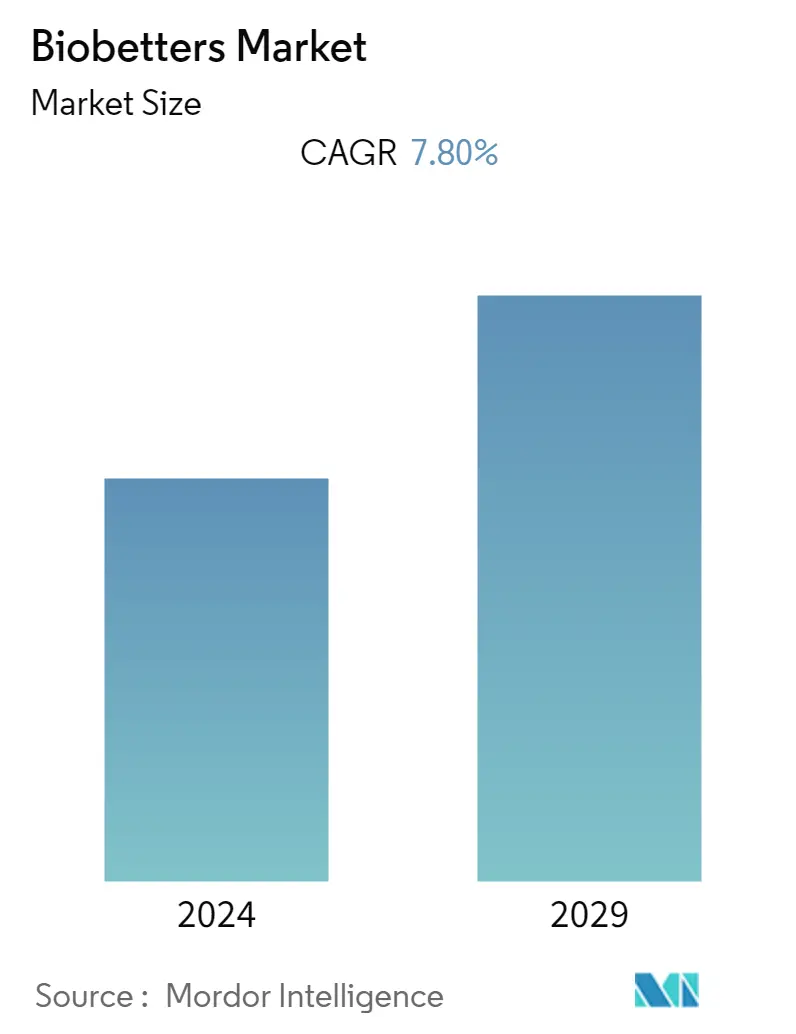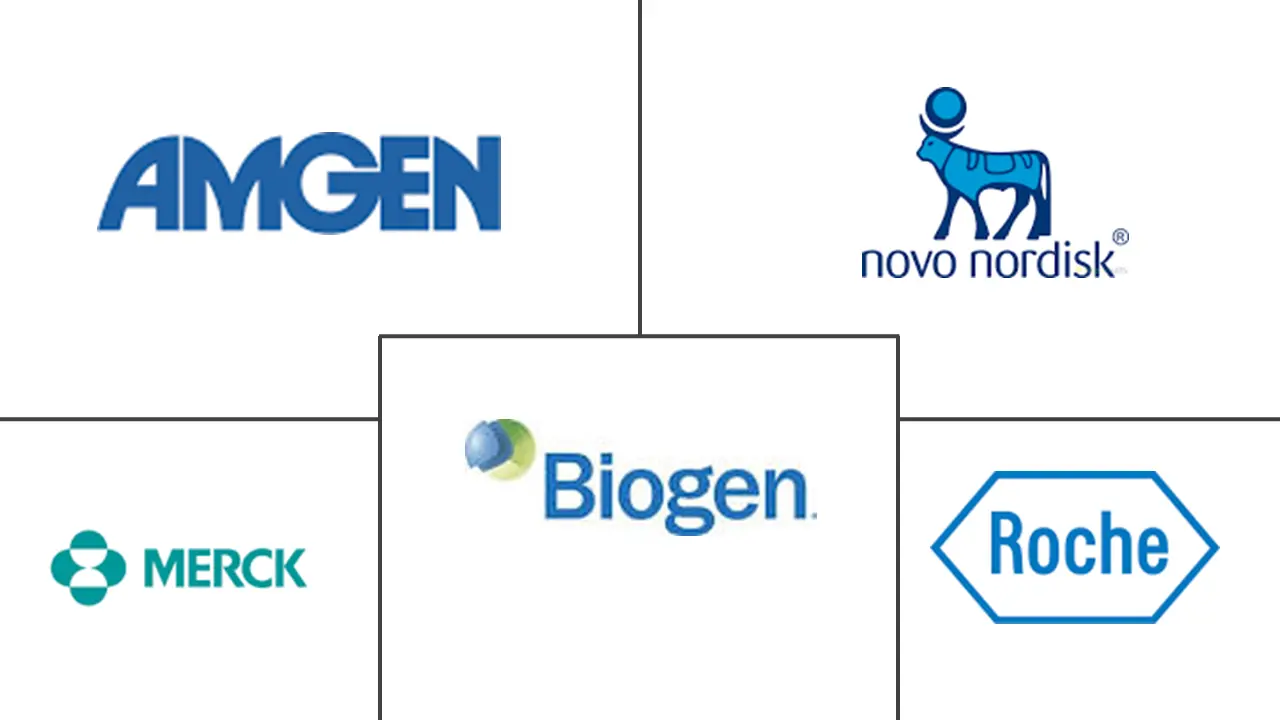Market Size of Biobetters Industry

| Study Period | 2019 - 2029 |
| Base Year For Estimation | 2023 |
| CAGR | 7.80 % |
| Fastest Growing Market | Asia Pacific |
| Largest Market | North America |
| Market Concentration | Medium |
Major Players
*Disclaimer: Major Players sorted in no particular order |
Biobetters Market Analysis
The Biobetters market is expected to grow with an anticipated CAGR of 7.8%, during the forecast period.
Patients suffering from various medical conditions were at high risk of getting severe illnesses as a result of COVID-19 infections during the pandemic. These conditions include diabetes, cancer, renal failure, and neurodegenerative disease. For instance, according to the data updated by CDC in May 2022, it was observed that people younger than 18 with COVID-19 infections were up to 2.5 times more likely to be newly diagnosed with diabetes in the months after infection. Thus, the increased risk of these medical conditions during the pandemic had a significant impact on the usage of biobetter medications. Moreover, according to an article published by SpringerLink in January 2022, experts around the world agreed that subcutaneous biobetters could play an important role during health emergencies, such as the COVID-19 pandemic. Thus, the COVID-19 pandemic impacted the market significantly during the initial phase. However, as the pandemic has subsided currently, the studied market is expected to have normal growth during the forecast period of the study. The major factors that are enhancing the market growth include superior therapeutic efficacy and lower adverse effects, comparatively easier and less costly manufacturing processes, non-patent and market exclusivity, longer product half-life, less dosing frequency, and high investment opportunities.
According to an article published by Elsevier in January 2022, biobetters are improved biological drugs that usually have better pharmacokinetics, and techniques such as glycosylation and PEGylation are the most common strategies to develop biobetters. The source also stated that innovative trends in genetic engineering are promising for biobetters development. Thus, the increasing advantages of biobetters along with the rising biobetter development techniques are expected to boost market growth.
Furthermore, according to an article published by PubMed Central in January 2022, biobetters are considered better than the original biologic in one or more parameters and it is estimated that with a proper target and a highly efficacious original biologic, the chances of a biobetter reaching the production stage are incredibly high. The source also mentioned that the duration of research and development of a biobetter is comparatively much shorter than an innovator molecule. Thus, the superior therapeutic efficacy of biobetters and the comparatively easier and less costly manufacturing processes are expected to boost market growth.
Moreover, the increasing developments regarding biobetters are also enhancing market growth. For instance, in April 2021, the European Medicines Agency (EMA) fully backed the use of Celltrion Healthcare's biobetter subcutaneous infliximab without initial intravenous loading doses. Securing the regulatory recommendation boosts Celltrion's efforts to outcompete Johnson & Johnson's Remicade and its biosimilar rivals.
Thus, the aforementioned factors such as the increasing advantages of biobetters along with the rising biobetter development techniques, the superior therapeutic efficacy of biobetters and the comparatively easier and less costly manufacturing processes, and the increasing developments by various organizations are expected to boost the market growth. However, high investment in research and development and increasing biosimilar competition are expected to impede market growth.
Biobetters Industry Segmentation
As per the scope of the report, biobetters, also known as biosuperiors, are recombinant protein drug from the same class of an existing biopharmaceutical, however not identical and are superior to the original. It is not completely a new drug and also not the generic version of an existing drug. It is a biological product developed with an intention to improve the clinical efficacy, enhancing tolerability and reducing the dosing/administration frequency. Biobetters are the upgraded versions of the existing biologics. The Biobetters market is segmented by Drug Class (Erythropoeitin Biobetters, Insulin Biobetters, G- CSF Biobetters, Monoclonal Antibodies Biobetters, Anti-Haemophlic factor and Other Biological Drug Biobetters), Application (Cancer, Diabetes, Renal Disease, Neurodegenerative Disease, Genetic Disorders, and Others), Route of Administration (Subcutaneous, Oral, Inhaled, Intravenous, and Others), Distribution Channel (Hospital Pharmacies, Retail Pharmacies, and Online Pharmacies) and Geography (North America, Europe, Asia-Pacific, Middle East and Africa, and South America). The market report also covers the estimated market sizes and trends for 17 different countries across major regions, globally. The report offers the value (in USD million) for the above segments.
| By Drug Class | |
| Erythropoietin Biobetters | |
| Insulin Biobetters | |
| G-CSF Bioreactors | |
| Monoclonal Antibodies Biobetters | |
| Anti-Haemophilic Factor | |
| Other Biological Drug Biobetters |
| By Application | |
| Cancer | |
| Diabetes | |
| Renal Disease | |
| Neurodegenerative Disease | |
| Genetic Disorders | |
| Others |
| By Route of Administration | |
| Subcutaneous | |
| Oral | |
| Inhaled | |
| Intravenous | |
| Others |
| By Distribution Channel | |
| Hospital Pharmacies | |
| Retail Pharmacies | |
| Online Pharmacies |
| Geography | ||||||||
| ||||||||
| ||||||||
| ||||||||
| ||||||||
|
Biobetters Market Size Summary
The biobetters market is poised for significant growth, driven by factors such as superior therapeutic efficacy, reduced adverse effects, and cost-effective manufacturing processes. Biobetters, which are improved biological drugs, leverage techniques like glycosylation and PEGylation to enhance pharmacokinetics, offering advantages over original biologics. The market's expansion is further supported by the increasing prevalence of chronic diseases, such as cancer and diabetes, which heightens the demand for advanced therapeutic solutions. The COVID-19 pandemic initially impacted the market by increasing the risk of severe illnesses, thereby boosting the use of biobetter medications. As the pandemic subsides, the market is expected to return to normal growth, supported by ongoing innovations in genetic engineering and regulatory approvals that facilitate the development and adoption of biobetters.
North America is anticipated to be a key region in the biobetters market, attributed to its growing geriatric population and the rising incidence of chronic diseases. The presence of major industry players and substantial research and development activities further bolster the market's growth prospects in this region. The competitive landscape is dominated by significant companies such as Amgen Inc., Novo Nordisk A/S, and F. Hoffmann-La Roche AG, which are actively investing in research, acquisitions, and collaborations to maintain their market positions. Despite the promising growth trajectory, challenges such as high research and development costs and increasing competition from biosimilars may impede market progress. Nonetheless, the ongoing advancements and strategic initiatives by key players are expected to drive the market forward during the forecast period.
Biobetters Market Size - Table of Contents
-
1. MARKET DYNAMICS
-
1.1 Market Overview
-
1.2 Market Drivers
-
1.2.1 Superior Therapeutic Efficacy and Lower Adverse Effects
-
1.2.2 Comparatively Easier and Less Costly Manufacturing Processes
-
1.2.3 Non- Patent and Market Exclusivity
-
1.2.4 Longer product Half-life and Less Dosing Frequency
-
1.2.5 High Investment Opportunities
-
-
1.3 Market Restraints
-
1.3.1 High Investment in Research and Development
-
1.3.2 Increasing Biosimilar Competition
-
-
1.4 Porter's Five Force Analysis
-
1.4.1 Threat of New Entrants
-
1.4.2 Bargaining Power of Buyers/Consumers
-
1.4.3 Bargaining Power of Suppliers
-
1.4.4 Threat of Substitute Products
-
1.4.5 Intensity of Competitive Rivalry
-
-
-
2. MARKET SEGMENTATION (Market Size by Value - USD million)
-
2.1 By Drug Class
-
2.1.1 Erythropoietin Biobetters
-
2.1.2 Insulin Biobetters
-
2.1.3 G-CSF Bioreactors
-
2.1.4 Monoclonal Antibodies Biobetters
-
2.1.5 Anti-Haemophilic Factor
-
2.1.6 Other Biological Drug Biobetters
-
-
2.2 By Application
-
2.2.1 Cancer
-
2.2.2 Diabetes
-
2.2.3 Renal Disease
-
2.2.4 Neurodegenerative Disease
-
2.2.5 Genetic Disorders
-
2.2.6 Others
-
-
2.3 By Route of Administration
-
2.3.1 Subcutaneous
-
2.3.2 Oral
-
2.3.3 Inhaled
-
2.3.4 Intravenous
-
2.3.5 Others
-
-
2.4 By Distribution Channel
-
2.4.1 Hospital Pharmacies
-
2.4.2 Retail Pharmacies
-
2.4.3 Online Pharmacies
-
-
2.5 Geography
-
2.5.1 North America
-
2.5.1.1 United States
-
2.5.1.2 Canada
-
2.5.1.3 Mexico
-
-
2.5.2 Europe
-
2.5.2.1 Germany
-
2.5.2.2 United Kingdom
-
2.5.2.3 France
-
2.5.2.4 Italy
-
2.5.2.5 Spain
-
2.5.2.6 Rest of Europe
-
-
2.5.3 Asia Pacific
-
2.5.3.1 China
-
2.5.3.2 Japan
-
2.5.3.3 India
-
2.5.3.4 Australia
-
2.5.3.5 South Korea
-
2.5.3.6 Rest of Asia-Pacific
-
-
2.5.4 Middle East and Africa
-
2.5.4.1 GCC
-
2.5.4.2 South Africa
-
2.5.4.3 Rest of Middle East and Africa
-
-
2.5.5 South America
-
2.5.5.1 Brazil
-
2.5.5.2 Argentina
-
2.5.5.3 Rest of South America
-
-
-
Biobetters Market Size FAQs
What is the current Biobetters Market size?
The Biobetters Market is projected to register a CAGR of 7.80% during the forecast period (2024-2029)
Who are the key players in Biobetters Market?
Amgen Inc., Novo Nordisk A/s, F.Hoffmann-La Roche AG, Merck & Co., Inc. and Biogen Inc. are the major companies operating in the Biobetters Market.

